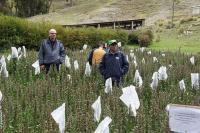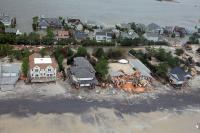-
Looking for ways to predict response to hurricane evacuation orders
Millions of people will likely be in harm’s way as a new hurricane season unfolds in the United States. The National Oceanic and Atmospheric Administration predicts up to eight hurricanes in the 2016 season, and as many as four major storms with winds of 111 miles per hour or more. What people do – or do not do – to get out of harm’s way is of keen interest to disaster and emergency response officials. Plans and contingencies work best when they are based on reliable predictions.
-
-
Climate assessment must be relevant and useful to policymakers
Climate change assessments must be more relevant to policymakers’ needs, experts say. They argue that coming off the Paris agreement late last year, ambition for fighting climate change is high. They assert that groups like the Intergovernmental Panel on Climate Change (IPCC) should capitalize on this increased enthusiasm by integrating studies and presenting their results in ways that are useful to policymakers.
-
-
We need better information to understand extreme weather
Scientists need more credible and relevant information to help communities become more resilient to extreme weather events such as floods. Researchers need improved techniques to be able to understand why the climate is changing, and the part humans play in this process, experts say.
-
-
Crop breeding is not keeping pace with climate change

Crop yields will fall within the next decade due to climate change unless immediate action is taken to speed up the introduction of new and improved varieties, experts have warned. The researchers focused on maize in Africa but the underlying processes affect crops across the tropics.
-
-
Datacasting helps first responders with live video streaming via smartphone

When torrential storms caused widespread flooding in Houston, Texas, in mid-April, first responders needed a way securely to share information amongst their many organizations. Luckily the DHS S&T First Responders Group’s (FRG) datacasting system was available. Datacasting provides public safety users with the capability to transmit secure video and data over existing broadcast television signals to a targeted audience. Even in an emergency situation, where other wireless services often fail due to network congestion, datacasting still provides a reliable platform to quickly send large files.
-
-
The contribution of human dynamics to coastal communities’ resilience
The National Academies of Sciences has established a $10 million grants program to fund projects that enhance the science and practice of coastal community resilience in the Gulf of Mexico region. Rather than focus on infrastructure needs or the built environment, as many existing resilience-focused programs do, the new grants program will support the study of the human dynamics that influence a community’s ability to respond to adverse events.
-
-
Better understanding – and forecasting -- of earthquakes

Researchers have broken new ground in understanding the complexity of earthquakes and the possibility to forecast them. The researchers used GPS records of surface motion to map the 7.8 magnitude Gorkha earthquake, which broke a 150-kilometer section of the Himalayas in April 2015, terminating close to Kathmandu.
-
-
Western U.S. braces for “dangerous and deadly” 120 degrees heatwave

Forecasters have warned that temperatures in the western United States are set to reach 120 degrees in a “rare, dangerous, and deadly” heatwave. The forecasts have worried officials, who are bracing for devastating wildfires and power cuts which will knock out air-conditioning systems, leading to heat-related fatalities. The area which will be subjected to the heat wave stretches from Oklahoma to California. It is home to sixty-six million people, one-fifth of the U.S. population.
-
-
Year-long heat streak results in new global heat records
Fresh out of the oven that was a warm start to the year, global temperatures are on a roll: For the 13th consecutive month, the globe was record warm in May — the longest such stretch in 137 years of record-keeping. The more than yearlong heat streak also resulted in other new global heat records.
-
-
Future summers could regularly be hotter than the hottest summers on record
In fifty years, summers across most of the globe could regularly be hotter than any summer experienced so far by people alive today, according to a new study. If climate change continues on its current trajectory, the probability that any summer between 2061 and 2080 will be warmer than the hottest on record is 80 percent across the world’s land areas, excluding Antarctica, which was not studied. If greenhouse gas emissions are reduced, however, that probability drops to 41 percent, according to the study.
-
-
Danger from extreme storms, high seas on the rise
Storms that battered Australia’s east coast are a harbinger of things to come and a stark reminder of the need for a national effort to monitor the growing threat from climate change, researchers warn. “The damage we’ve seen is a harbinger of what’s to come,” said one expert. “Climate change is not only raising the oceans and threatening foreshores, but making our coastlines much more vulnerable to storm damage. What are king high tides today will be the norm within decades.”
-
-
France unveils app to alert people to terror attacks
Euro 2016 soccer tournament begins on Friday, and as part of the massive security operation undertaken to secure the ten millions spectators who will be watching the games from 10 June to 10 July, the French government has created a smartphone app designed to send warnings directly to people’s phones in the event of a bombing, shooting, or other disaster.
-
-
New app to gather public input on flash flooding conditions
A new Android cell phone app called iSeeFlood encourages the public to file timely reports when they see flooding of varying severity on the streets, in and around their houses, and in streams and creeks. Such flash floods can be dangerous to pedestrians and motorists alike.
-
-
Cities can prepare for hurricane season by reforming shortsighted and outdated laws
In the past decade major storms have devastated U.S. coastal cities from Galveston to Atlantic City and New York. They also have ravaged inland capitals, including Baton Rouge, Richmond, and Montpelier. Ensuring that our cities have the legal infrastructure in place to build safer, more efficient, and more equitable neighborhoods and communities after storms is just as important as preparing homes and businesses to ride out those storms.
-
-
New USGS models help predict storm effects on beaches

As the 2016 hurricane season opens, weather forecasters, emergency managers and coastal residents have access to tools developed by the USGS which predict, more precisely than ever, where beach erosion and beachfront flooding will take place during hurricanes and other storms.
-
More headlines
The long view
Strengthening School Violence Prevention
Violence by K-12 students is disturbingly common. Ensuring that schools have effective ways to identify and prevent such incidents is becoming increasingly important. Expanding intervention options and supporting K-12 school efforts in Behavioral Threat Assessment and Management (BTAM) would help.
Huge Areas May Face Possibly Fatal Heat Waves if Warming Continues
A new assessment warns that if Earth’s average temperature reaches 2 degrees C over the preindustrial average, widespread areas may become too hot during extreme heat events for many people to survive without artificial cooling.
Trump’s Cuts to Federal Wildfire Crews Could Have “Scary” Consequences
President Donald Trump’s moves to slash the federal workforce have gutted the ranks of wildland firefighters and support personnel, fire professionals warn, leaving communities to face deadly consequences when big blazes arrive this summer. States, tribes and fire chiefs are preparing for a fire season with minimal federal support.
